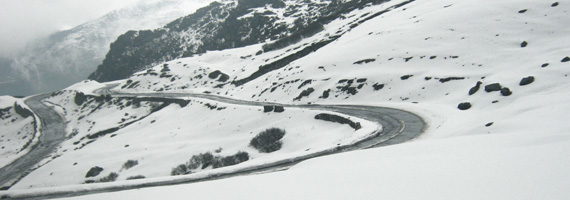
Located at a height of around 10,100 feet on the rugged terrain of the lower Himalayas in East Sikkim, Zuluk or Dzuluk is a small village beside a winding road. It was once a transit point to the historic Silk Route from Tibet to India. It is relatively an emerging and offbeat destination in East Sikkim. This small village accommodates a population of around 700 people. There is also an Indian Army base at Zuluk, which has been used as a transit camp for the army movement to the Chinese border, a few kilometres away. It is the very first village within this whole Silk Route circuit to offer home-stay facilities for tourists. Zuluk itself does not offer views of the snow peaks but only 14 kms away the Thambi View Point offers a panoramic view of the entire Mt. Kanchenjungha range.
What to see in Zuluk:
Zuluk is a hilltop and a transit point within the Silk Route. The road through Zuluk makes almost 32 hairpin turns to reach Lungthung, which makes it a unique engineering feat. There is a local Nag Temple here. The temple has a cave like structure and the deity of King Cobra or Nag, famous Hindu mythical god is worshipped in the temple. Another great attraction of Zuluk lies in watching the sunrise over Mt. Kanchenjungha and its allied peaks from Thambi View Point (around 14 kms away) at 11,200 feet. The glittering rays of the rising sun kisses the snow clad peak of Mt. Kanchenjungha, which slowly turns crimson and then golden and finally silver. The spectacle is truly breathtaking. While staying at Zuluk you can cover Padamchen, Lungthung, Nathang, Kupup Lake, Tukla Valley and all other spots in the Silk Route circuit in day trips. Zuluk has high diversity of Himalayan fauna. The place shelters variety of birds like Monal Pheasant, Blood Pheasant, Khaleez Pheasant, Snow Pheasant and others. You may also catch a glimpse of Himalayan Weasel or A Martin. Sighting of Red Panda, wild dog and deer in the high hills have also been recorded.
Accommodation in Zuluk:
There are few nice, clean and comfortable homestays in Zuluk with attached Western bathrooms. The beds are well made-up and decked with sufficient amounts of blankets and pillows. Hot water is usually supplied in buckets and food is home-cooked, nice and warm served in dining rooms with Bukharis (a traditional wood burning room heater). There are no televisions in rooms but you would find one in the dining room. Food is typically Indian cuisine with vegetables, egg and chicken being the most prominent fares. Fish is usually not available.
Best time to visit Zuluk:
During August and September, Zuluk is drenched is a riot of colours of wild flowers. The whole region is covered in various wild flowers. From January to April Zuluk is covered in snow. The rainy season of May to July is usually foggy but the rest of the year it has nice sparkling weather.
